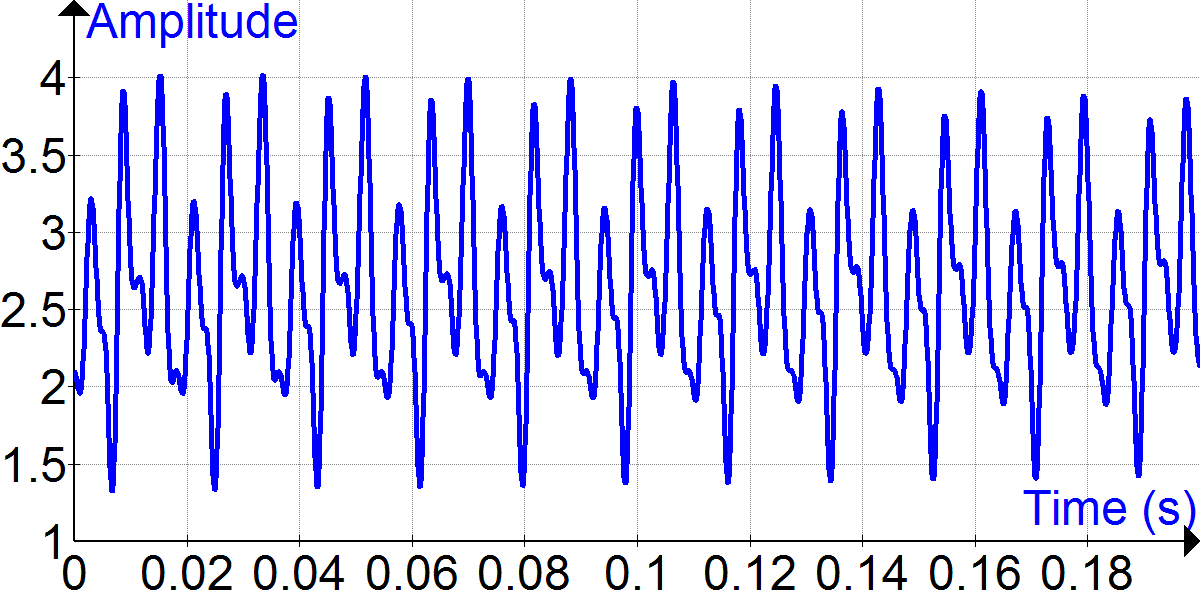
Harmonic analysis
Harmonic analysis is a branch of mathematics concerned with investigating the connections between a function and its representation in frequency. The frequency representation is found by using the Fourier transform for functions on the real line or by Fourier series for periodic functions. Generalizing these transforms to other domains is generally called Fourier analysis, although the term is sometimes used interchangeably with harmonic analysis. Harmonic analysis has become a vast subject with applications in areas as diverse as number theory, representation theory, signal processing, quantum mechanics, tidal analysis and neuroscience.
For the process of determining the structure of a piece of music, see Harmony.The term "harmonics" originated as the Ancient Greek word harmonikos, meaning "skilled in music".[1] In physical eigenvalue problems, it began to mean waves whose frequencies are integer multiples of one another, as are the frequencies of the harmonics of music notes. Still, the term has been generalized beyond its original meaning.
Classical Harmonic Analysis[edit]
Historically Harmonic functions were the solutions of Laplace equation,[2] this concept was extended first to special functions,[3] then to general elliptic operators[4] and nowadays harmonic functions are considered as a generalization of periodic functions[5] on function spaces defined on a manifold, for example as solutions of general, not necessarly elliptic, partial differential equations including some boundary conditions that may drive their symmetry or periodicity.[6]
The classical Fourier transform on Rn is still an area of ongoing research, particularly concerning Fourier transformation on more general objects such as tempered distributions. For instance, if we impose some requirements on a distribution f, we can attempt to translate these requirements into the Fourier transform of f. The Paley–Wiener theorem is an example. The Paley–Wiener theorem immediately implies that if f is a nonzero distribution of compact support (these include functions of compact support), then its Fourier transform is never compactly supported (i.e., if a signal is limited in one domain, it is unlimited in the other). This is an elementary form of an uncertainty principle in a harmonic-analysis setting.
Fourier series can be conveniently studied in the context of Hilbert spaces, which provides a connection between harmonic analysis and functional analysis. There are four versions of the Fourier transform, dependent on the spaces that are mapped by the transformation:
Abstract harmonic analysis[edit]
Abstract harmonic analysis is primarily concerned with how real or
complex-valued functions (often on very general domains) can be studied using symmetries such
as translations or rotations (for instance via the Fourier transform and its relatives); this field is of
course related to real-variable harmonic analysis, but is perhaps closer in spirit to representation theory and functional analysis.[7]
One of the most modern branches of harmonic analysis, having its roots in the mid-20th century, is analysis on topological groups. The core motivating ideas are the various Fourier transforms, which can be generalized to a transform of functions defined on Hausdorff locally compact topological groups.[8]
One of the major results in the theory of functions on abelian locally compact groups is called Pontryagin duality.
Harmonic analysis studies the properties of that duality. Different generalization of Fourier transforms attempts to extend those features to different settings, for instance, first to the case of general abelian topological groups and second to the case of non-abelian Lie groups.[9]
Harmonic analysis is closely related to the theory of unitary group representations for general non-abelian locally compact groups. For compact groups, the Peter–Weyl theorem explains how one may get harmonics by choosing one irreducible representation out of each equivalence class of representations.[10] This choice of harmonics enjoys some of the valuable properties of the classical Fourier transform in terms of carrying convolutions to pointwise products or otherwise showing a certain understanding of the underlying group structure. See also: Non-commutative harmonic analysis.
If the group is neither abelian nor compact, no general satisfactory theory is currently known ("satisfactory" means at least as strong as the Plancherel theorem). However, many specific cases have been analyzed, for example, SLn. In this case, representations in infinite dimensions play a crucial role.
